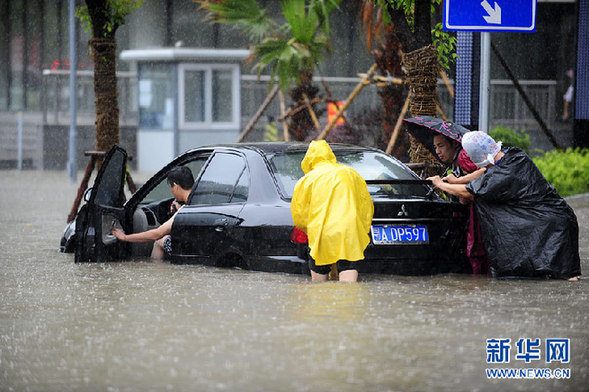

 |
In the course of the just-concluded flood season, 19 of the 30 pilot "sponge cities" in China witnessed flooding, which has triggered doubts about the efficacy of the whole sponge city project.
The idea behind sponge cities is simple: collect and store excess water during periods of heavy rainfall, and then parcel it out during subsequent dry periods. The Ministry of Housing and Urban-Rural Development defended the plan on Sept. 12, saying that the sponge cities will not become effective immediately, and that their construction is still accelerating.
According to guidelines for the sponge city project, by 2020, 20 percent of urban areas will be able to absorb excess rainwater through upgraded sewer systems, filtration pools, wetlands and permeable public spaces; by 2030, that figure will rise to 30 percent, an official with the ministry said.
Xie Yingxia, deputy director of the Water Affairs Institute under the China Academy of Urban Planning and Design, noted that the public should not deny the utility of sponge cities just because of flooding caused by extremely heavy rainfall. Xie added that even sponge cities are only effective at offsetting flooding within a certain range.
In 2015 and 2016, the Ministry of Finance, the Ministry of Housing and Urban-Rural Development and the Ministry of Water Resources selected 30 cities, including Beijing, Shanghai and Shenzhen, in which to pilot the sponge city project.
 Fire brigade in Shanghai holds group wedding
Fire brigade in Shanghai holds group wedding Tourists enjoy ice sculptures in Datan Town, north China
Tourists enjoy ice sculptures in Datan Town, north China Sunset scenery of Dayan Pagoda in Xi'an
Sunset scenery of Dayan Pagoda in Xi'an Tourists have fun at scenic spot in Nanlong Town, NW China
Tourists have fun at scenic spot in Nanlong Town, NW China Harbin attracts tourists by making best use of ice in winter
Harbin attracts tourists by making best use of ice in winter In pics: FIS Alpine Ski Women's World Cup Slalom
In pics: FIS Alpine Ski Women's World Cup Slalom Black-necked cranes rest at reservoir in Lhunzhub County, Lhasa
Black-necked cranes rest at reservoir in Lhunzhub County, Lhasa China's FAST telescope will be available to foreign scientists in April
China's FAST telescope will be available to foreign scientists in April "She power" plays indispensable role in poverty alleviation
"She power" plays indispensable role in poverty alleviation Top 10 world news events of People's Daily in 2020
Top 10 world news events of People's Daily in 2020 Top 10 China news events of People's Daily in 2020
Top 10 China news events of People's Daily in 2020 Top 10 media buzzwords of 2020
Top 10 media buzzwords of 2020 Year-ender:10 major tourism stories of 2020
Year-ender:10 major tourism stories of 2020 No interference in Venezuelan issues
No interference in Venezuelan issues
 Biz prepares for trade spat
Biz prepares for trade spat
 Broadcasting Continent
Broadcasting Continent Australia wins Chinese CEOs as US loses
Australia wins Chinese CEOs as US loses